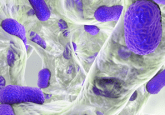Surviving and thriving: how some antibiotics help resistant bacteria to flourish

Some antibiotics kill good bacteria, causing antibiotic-resistant bacteria in the gut to thrive.
Research from Imperial College London (UK) has shown that some antibiotics actually cause antibiotic-resistant bacteria in the gut to thrive by killing off beneficial bacteria. This research can be used in the short term to help clinicians with antibiotic prescription decisions and in the long term to develop ‘microbiome therapeutics’, which could help us in the fight against antibiotic resistance.
Some antibiotics target specific bacteria while others kill a range of bacteria, including both ‘bad’ pathogenic bacteria and ‘good’ bacteria that reside in our gut and play an important role in keeping us healthy. These ‘broad-spectrum’ antibiotics are often used as a last resort for difficult-to-treat or resistant infections, due to their harmful effects on beneficial bacteria. However, some bacteria are even resistant to broad-spectrum antibiotics.
Carbapenems are an example of a broad-spectrum antibiotic. Some Enterobacteriaceae bacteria, including strains of E. coli, are resistant to carbapenems. These bacteria reside in the gut but can spread and cause infections in other sites, for example bloodstream infections.
To investigate the effects of broad-spectrum antibiotics on gut bacteria, the researchers performed ex vivo fecal culture experiments to measure the effects of eight broad-spectrum antibiotics on the fecal microbiota from 11 healthy human donors. As expected, they found that the antibiotics decreased the abundance of several good bacterial families.
The researchers then used 1H-NMR spectroscopy to measure the effects of this on nutrient availability and metabolite production in the fecal cultures. They found that a decrease in good bacteria resulted in an increase in nutrient availability and reduced levels of inhibitory metabolites, which are waste products that stop pathogenic bacteria from growing. This allowed carbapenem-resistant Enterobacteriaceae (CRE) to thrive and form a reservoir of disease-causing bacteria in the gut.
 Monitoring local antimicrobial resistance prevalence using honey bees
Monitoring local antimicrobial resistance prevalence using honey bees
Honey bees show promise as biomonitors for tracking the spread of antimicrobial resistance.
First author Alexander Yip commented: “Understanding how antibiotics cause carbapenem-resistant Enterobacteriaceae to grow in the intestine means that we can develop new treatments to restrict their growth in the intestine, which will lead to a reduction in these antibiotic-resistant infections.”
To develop new treatments, the team first want to identify which good bacteria can out-compete pathogenic bacteria by making better use of the same nutrients and producing metabolites that inhibit the growth of the pathogenic bacteria.
They hope to use this information to create ‘microbiome therapeutics’. “When a patient is taking antibiotics, we could give them inhibitory metabolites to restrict the growth of resistant bacteria.” explained corresponding author Julie McDonald. “After a patient has stopped taking antibiotics, we could give them a mixture of beneficial gut bacteria to help their gut microbiome recover, restore depletion of nutrients, and restore production of inhibitory metabolites. These microbiome therapeutics could reduce the risk of patients developing invasive antibiotic resistant infections, reduce the recurrence of invasive CRE infections in chronically colonized patients, and reduce the spread of CRE to susceptible patients.”
In the meantime, the researchers say their results could be used to help clinicians when prescribing broad-spectrum antibiotics. For example, clinicians could avoid prescribing antibiotics that increase certain nutrients and decrease certain metabolites. Clinicians could also test patient fecal samples for these nutrients and metabolites to identify those at increased risk of CRE colonization.





